|
February 1, 2023

Our Forest Health Annual Report summarizes statewide surveys for insects and pests that cause trouble or concern in the woods. Watching trends and monitoring outbreaks allows public land managers and private woodland owners to keep their forests healthy by adjusting management approaches and preparing for future challenges.
So, what did we find?
Eastern larch beetle
Since the beginning of the eastern larch beetle outbreak in 2001, about 972,000 acres, or 69% of tamarack in Minnesota, have been impacted.
Spruce budworm
Most of the present outbreak is in northern St. Louis, Lake, and Cook counties. In 2022, spruce budworm impacted about 488,800 acres, the highest number in one year since 1995.
Spongy moth (formerly gypsy moth)
The number of moths captured by traps in 2022 was the highest in the history of trapping.
Read the 2022 Forest Health Annual Report.
Did you know?
Each year, the DNR and USDA Forest Service aerially survey much of Minnesota’s forests, tracking outbreaks of forest insect and disease damage. Past Forest Health Annual Reports (1969-present) are available online.
|